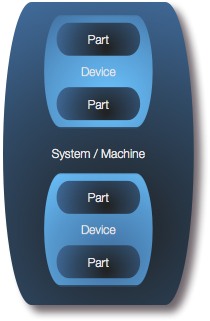Team:NTU-Singapore/Project/System
From 2009.igem.org
| Line 51: | Line 51: | ||
== Parts, devices & systems == | == Parts, devices & systems == | ||
| - | The first step to systemizing would be to recognize that any '''system''' is made up of '''devices''', which in turn consist of '''parts'''. This is known as an '''abstraction hierarchy'''. In the context of iGEM, parts would be functional gene sequences, devices would be individual Biobricks, and the resulting system is a coherent & working biological machine. | + | <div class="grid_4 alpha">[[Image:NTUsysdevpar.jpg|224px]]</div> |
| + | |||
| + | The first step to systemizing would be to recognize that any '''system''' is made up of '''devices''', which in turn consist of '''parts'''. This is known as an '''abstraction hierarchy'''. | ||
| + | |||
| + | In the context of iGEM, parts would be functional gene sequences, devices would be individual Biobricks, and the resulting system is a coherent & working biological machine.<br class="clear" /> | ||
Revision as of 05:48, 18 October 2009
Our Solution
In the previous section, we identified some characteristic conditions present at atherosclerotic sites.
Now we will start formulating a solution in the framework of a system. The idea here is to utilize the engineering approach to solve our problem. The engineering approach to solving problems is a logical and structured way to custom design a unique solution.
This approach suits the purposes of iGEM and Registry of Biological Parts very well, because the aim of synthetic biology is to systemize biology. This will empower us to engineer biological solutions to problems.
Parts, devices & systems
The first step to systemizing would be to recognize that any system is made up of devices, which in turn consist of parts. This is known as an abstraction hierarchy.
In the context of iGEM, parts would be functional gene sequences, devices would be individual Biobricks, and the resulting system is a coherent & working biological machine.
The purpose of an abstraction hierarchy is simple. By abstracting a synthetic genome into these layers, we can start to blackbox and isolate the gene sequences or the functions that we are interested in. For example, someone working on a device should not have to concern himself/herself with the specifics of the parts he/she uses to construct the device.
In this way, synthetic biology can be advanced in the same reductionistic way that has best suited the study of biology.
The Engineering Approach
Now that we understand what systemizing means, let's look at how we can use systems/sub-systems (devices) in the engineering process. Below is the typical flow of the engineering process. We have, in order of sequence:
- Problem Identification : In our case, we recognize atherosclerosis as our problem.
- System Specifications : We will identify the parameters that can be manipulated or need to be controlled.
- System Design : We will propose and design a system to solve the problem.
- Device Design : Design devices (and parts) that, when combined, fulfill the specifications of our system.
- Modelling : We simultaneously model both the system & its devices to identify bottlenecks.
- Prototyping : We will make a proof-of-concept that highlights the potential engineering difficulties.
- System Construction : If the prototype is successful, we can actually construct the intended system.
- Testing & Characterisation : We verify the functionality of our system & compare to the modelling.
So let's start to analyze our problem, atherosclerotic plaque, and layout our proposed solution according to these steps.
System Specifications
We have already identified the problem and collated its characteristics. So the logical next step is to define the system parameters or system specifications. Each of these parameters are chosen from the analysis of characteristics of physiological plaque inflammation.
 "
"

